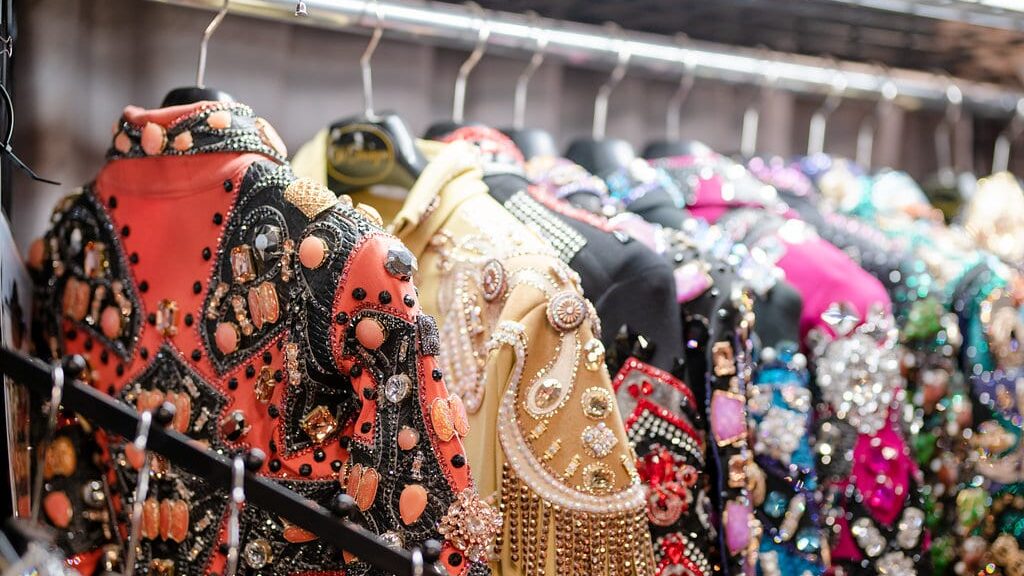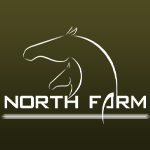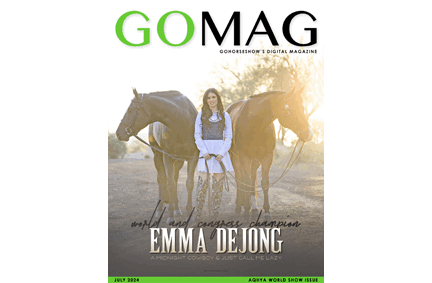It’s fashion month, and one of the most difficult things about planning a show wardrobe is staying in style while dressing for your unique body type. What looks good on one team may not look as good on another.
Indeed, many experts we’ve spoken to throughout fashion month have emphasized fit over fashion – your outfit could be very in style, but if it doesn’t fit your body right, it won’t have the impact in the pen that a well-fitting outfit would.
We spoke with leading fashion designer Paula Diuri of Paula’s Place for her tips on dressing for your body so you look and feel your best in the ring.
Discovering Your Body Type
Before discussing the various body types in detail, we recommend you know your measurements to determine which type best describes you.
Here are some basic instructions for measuring key areas of your body:
- Shoulders: Start at the tip of one shoulder and wrap the tape around you to determine your shoulder circumference.
- Bust/Chest: Pull the measuring tape taut across the fullest part of your bust/chest and around your back.
- Waist: Measure the smallest part of your natural waist, just above the belly button, all the way around your body.
- Hips: Start at one hip (below the hip bone) and wrap the tape measure around the largest part of your backside.
Remember, all body types are unique, and you may have traits of multiple types. Combine the advice from those types to create a plan that works best for you as an individual.
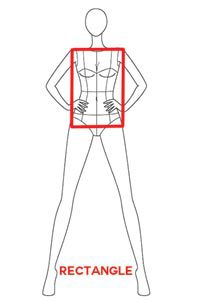 Rectangle Body Type
Rectangle Body Type
You are likely a “rectangle body type” if your shoulders and hips are proportionate with little definition in the waist.
For this body type, Paula recommends, “You want to use lines or a design that will create or emphasize your waist area to break up the line of your body. Shapes that curve toward the waist or use triangles to point to the waist will help you define that area.”
She continues, “You should avoid straight lines down the torso and lines going across the body in the waist area – you want to stay away from anything boxy.”
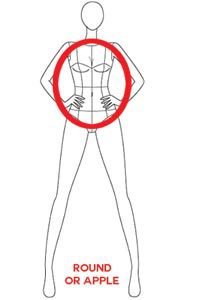 Round Body Type
Round Body Type
You are likely a “round body type” if your shoulders are broad, your hips are slim compared to the other measurements, and you do not have a clearly defined waist.
When dressing this body type, the key is to create the illusion of a waistline and balance your hips and shoulders.
Paula advises you utilize “an all-over print or solid color. You can angle the side stripes down using a stripe to give an illusion of a waist.”
She suggests you “avoid clothing with a definite design in the middle of the stomach or lower back area. Instead, use a design or prints that do not widen at the waist. You should also avoid horizontal designs or lines and lacing in the waist area.”
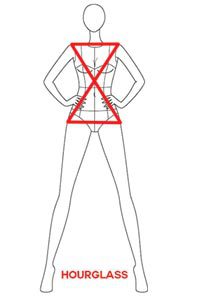 Hourglass Body Type
Hourglass Body Type
If your shoulders and hips are close to the same size and your waist is defined, you are likely an “hourglass body type.”
Paula recommends “use light colors at the shoulder area – it is best to avoid dark shoulders.” She believes “this is a great body type if you want to include a fun waist detail or shoulder pads to widen the shoulder area.”
Pear Body Type/Triangle
You are likely a “pear body type” if your hips are wider than your shoulders.
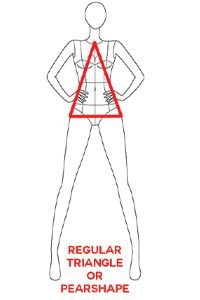 For this body type, Paula suggests that you “try to wear a longer style vest that covers the top of your chaps and belt. Therefore, it’s best to avoid a large belt buckle. Also, the base color of your shirt should be the same color as your chaps for color continuity. You want to draw the eye to your face or shoulders, so this body type can benefit from a hat color that stands out a little more.”
For this body type, Paula suggests that you “try to wear a longer style vest that covers the top of your chaps and belt. Therefore, it’s best to avoid a large belt buckle. Also, the base color of your shirt should be the same color as your chaps for color continuity. You want to draw the eye to your face or shoulders, so this body type can benefit from a hat color that stands out a little more.”
She says you should avoid “anything that cuts you off at the waist. I don’t recommend bolero vests or jackets as they tend to have the effect of cutting the body in half. Also, you don’t want designs that are shaped like a triangle that gets wider as it goes down toward the hip area. Instead, you want to focus on adding more design volume to your shoulder line to create a more balanced silhouette.”
Inverted Triangle Body Type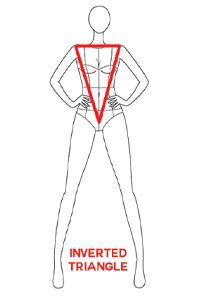 If your shoulders or bust are larger than your hips, you may be an “inverted triangle body type.”
If your shoulders or bust are larger than your hips, you may be an “inverted triangle body type.”
For this type, Paula likes to utilize a design with “a dark design or area on shoulders. You want the main focal point of the design down the center of the torso and on the bodice sides. The key to dressing this type is to add slightly more volume to your hips to balance your shoulders and bust.”
As a result, she recommends this body type avoids adding extra volume to the shoulder area. “You should try to avoid anything that ‘V’s up’ toward the shoulder area. Definitely stay away from big, oversized shoulder pads and any heavy embellishments on shoulders.”
Important Reminders
Just because something should work best for your body type, doesn’t mean it is a guarantee. “Try on your show clothes. See yourself in the mirror and settle on something that makes you happy and that you are proud to see yourself in.”

Paula also reminds us to try on our show clothes again before showing, as fit can change over time – particularly if you’ve lost or gained weight. Sometimes, pre-show alterations are necessary, and it is better to discover that in time to make those changes than right before your class.
She adds that before going to the show, you should ensure your riding clothing is comfortable to sit in and that your halter/showmanship outfits are comfortable to walk, stand, and run in.
Specifically, Paula advises that you ensure your pants aren’t too tight for horsemanship, which can inhibit your ability to straddle the saddle properly. You also want to ensure your jacket/shirt is sleek and doesn’t bunch up when seated.
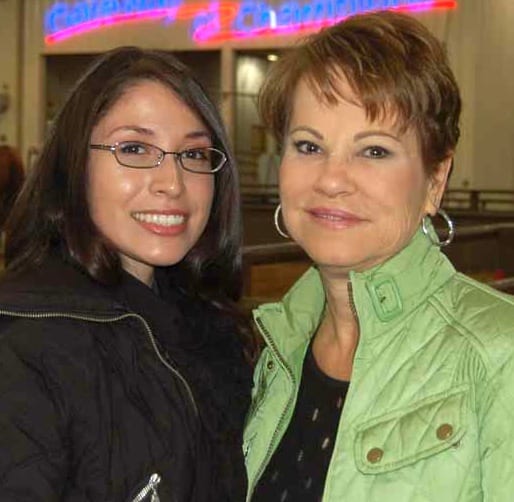 In the showmanship, she says you need to ensure your pants are long enough and the jacket doesn’t flop while you are running.
In the showmanship, she says you need to ensure your pants are long enough and the jacket doesn’t flop while you are running.
“All the detail and style in the world cannot compensate for a bad fit – it is the key to looking and feeling your best.”
She continues, “If I were to list the important factors for looking your best, fit would be the absolute most important factor. Second, do not forget to evaluate your undergarments (another aspect of fit). Your support system is so important! Finally, fabric choice and color, while important for a good look, should be the third factor in choosing an outfit.”
Finally, it is important to remember that, like our horses, we are working with the body we have. You are more likely to be harder on yourself than anyone else. If you dress to accentuate your body in its most flattering light, you will likely be more comfortable and confident when you show. When you feel your best, you look your best, and you show your best.


